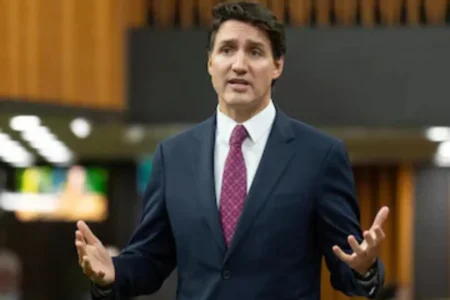In a pivotal address that has sparked widespread conversation, Canadian Prime Minister Justin Trudeau lamented the challenges faced by Canada’s immigration system following its reform during the COVID-19 pandemic. In a candid YouTube video, Trudeau shed light on how “bad actors” exploited the system, prompting a major policy shift to restrict immigration numbers and stabilize the nation’s population growth.
“In the last two years, our population has grown really fast, like a baby boom,” Trudeau explained. “This rapid growth, while initially beneficial, revealed weaknesses in our system, as increasingly bad actors like fake colleges and large corporations exploited the new policies for their gain.”
Why Canada Reformed Its Immigration Policy Post-COVID
During the pandemic, Canada made sweeping changes to its immigration policy, allowing an influx of immigrants to combat labor shortages. The approach was lauded as innovative, helping fill critical workforce gaps. However, it inadvertently created opportunities for exploitation. Trudeau acknowledged that certain organizations prioritized profits over ethical practices.
“Far too many colleges and universities used international students to raise their bottom line by charging exorbitant fees,” he said. “Additionally, large corporations employed these workers at lower wages, undermining the livelihoods of Canadians.”
This exploitation left many immigrants vulnerable, drawn by false promises of jobs, diplomas, and citizenship pathways that often never materialized.
Population Growth vs. Infrastructure
The unintended side effect of these policies was a population surge that outpaced Canada’s infrastructure, particularly housing. “Looking back, when the post-pandemic boom cooled and businesses no longer needed the additional workforce, we could have acted quicker,” Trudeau admitted.
To address this imbalance, the government announced a phased reduction in immigration numbers. Immigration Minister Marc Miller outlined a plan to reduce the number of permanent residents from 500,000 in 2024 to 395,000 in 2025, with subsequent annual decreases of 4% through 2027. For the first time, temporary resident numbers will also face limits, cutting expected arrivals by hundreds of thousands.
“This pause will help stabilize population growth while housing stocks and community resources catch up,” Trudeau explained.
A Controversial Move Amid Political Pressure
The timing of this policy shift is significant, as Trudeau faces re-election in 2025. Polls suggest a growing number of Canadians are dissatisfied with his leadership, putting pressure on the Liberal Party leader to make impactful changes.
Trudeau’s rhetoric echoed some criticisms seen in global politics, particularly those of U.S. leaders who have accused corporations of using immigration to suppress wages. By taking a strong stance, Trudeau hopes to align with public sentiment and address key concerns about affordability and sustainability.
Looking Ahead: A Balanced Immigration System
Despite the current restrictions, Trudeau emphasized that Canada remains committed to immigration as a cornerstone of its identity. The pause, he said, is temporary and aimed at creating a more balanced system.
“We will revisit these policies once our economy and communities have caught up,” he assured. “Our goal is to ensure that when immigration growth resumes, it benefits everyone—immigrants and Canadians alike.”
A Turning Point for Canada
Canada’s immigration reform post-COVID is not merely a response to immediate challenges but a blueprint for building a sustainable future. Trudeau’s acknowledgment of past mistakes and his willingness to implement difficult yet necessary measures signal a transformative moment in Canadian policymaking.
Also Read:Thangasvari Suppiah: Champion of Women’s Rights and Cultural Pride
